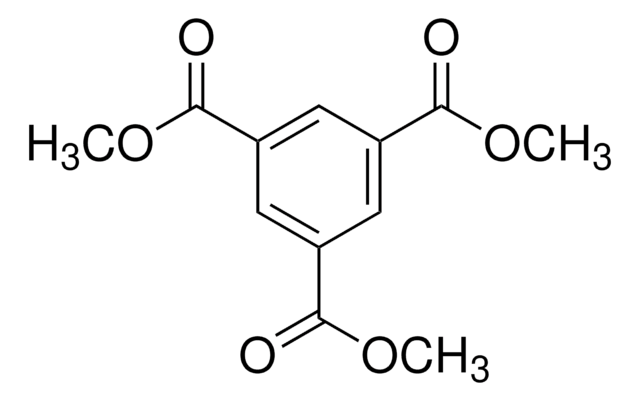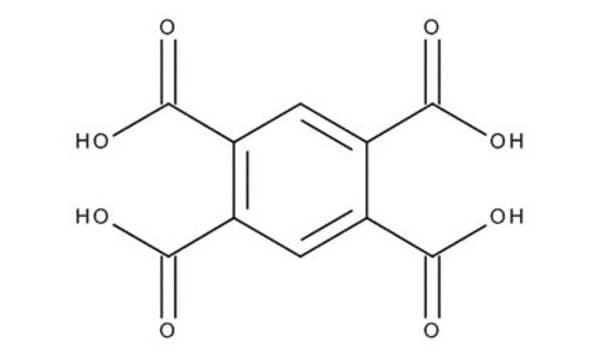B4589
1,2,4-Benzenetricarboxylic acid
≥99%
Synonym(s):
Benzene-1,2,4-tricarboxylic acid, Trimellitic acid
Sign Into View Organizational & Contract Pricing
All Photos(1)
About This Item
Linear Formula:
C6H3(CO2H)3
CAS Number:
Molecular Weight:
210.14
Beilstein:
2214815
EC Number:
MDL number:
UNSPSC Code:
12352100
PubChem Substance ID:
NACRES:
NA.22
Recommended Products
Assay
≥99%
form
powder
mp
229-231 °C (dec.) (lit.)
SMILES string
OC(C1=C(C(O)=O)C=C(C(O)=O)C=C1)=O
InChI
1S/C9H6O6/c10-7(11)4-1-2-5(8(12)13)6(3-4)9(14)15/h1-3H,(H,10,11)(H,12,13)(H,14,15)
InChI key
ARCGXLSVLAOJQL-UHFFFAOYSA-N
Looking for similar products? Visit Product Comparison Guide
Related Categories
Application
1,2,4-Benzenetricarboxylic acid (trimellitic acid) is generally used as carboxylate ligand in the synthesis of a wide range of metal-organic frameworks (MOFs). It can also be used to synthesize Ln3+ encapsulated nanocrystals which exhibit white-light luminescence.
Signal Word
Warning
Hazard Statements
Precautionary Statements
Hazard Classifications
Eye Irrit. 2 - Skin Irrit. 2 - STOT SE 3
Target Organs
Respiratory system
Storage Class Code
11 - Combustible Solids
WGK
WGK 2
Flash Point(F)
Not applicable
Flash Point(C)
Not applicable
Personal Protective Equipment
dust mask type N95 (US), Eyeshields, Gloves
Choose from one of the most recent versions:
Already Own This Product?
Find documentation for the products that you have recently purchased in the Document Library.
Customers Also Viewed
Imparting Tunable and white-light luminescence to a nanosized metal?organic framework by controlled encapsulation of lanthanide cations.
Zhou Y and Yan B
Inorganic Chemistry, 53(7), 3456-3463 (2014)
A three-dimensional metal?organic framework with a distorted Kagome related layer showing canted antiferromagnetic behaviour.
Mahata P, et al.
Chemical Communications (Cambridge, England), 11, 1278-1280 (2008)
L G Rushing et al.
Journal of analytical toxicology, 6(6), 290-293 (1982-11-01)
Trimellitic anhydride has widespread usage in a variety of industrial processes. Inhalation of the airborne dust and fumes generated by these processes is the primary route of occupational exposure leading to a variety of respiratory maladies. Because of its extensive
Construction, characteristics and application of a benzene-1,2,4-tricarboxylic acid selective electrode.
N E Nashed et al.
The Analyst, 112(2), 205-207 (1987-02-01)
Yvonne C M Staal et al.
Toxicologic pathology, 42(7), 1130-1142 (2014-04-08)
The interaction between exposure to nanomaterials and existing inflammatory conditions has not been fully established. Multiwalled carbon nanotubes (MWCNT; Nanocyl NC 7000 CAS no. 7782-42-5; count median diameter in atmosphere 61 ± 5 nm) were tested by inhalation in high
Our team of scientists has experience in all areas of research including Life Science, Material Science, Chemical Synthesis, Chromatography, Analytical and many others.
Contact Technical Service









